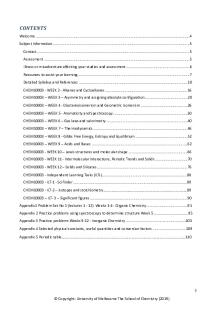04B Counters FSM - tutorial work PDF

| Title | 04B Counters FSM - tutorial work |
|---|---|
| Author | muhammad samir |
| Course | Digital Systems |
| Institution | University of Greenwich |
| Pages | 19 |
| File Size | 732.1 KB |
| File Type | |
| Total Downloads | 93 |
| Total Views | 138 |
Summary
tutorial work...
Description
Sequential Circuit Design (cont’d) • Build a design table that consists of ∗ Current state output ∗ Next state output ∗ JK inputs for each flip-flop
• Binary counter example ∗ ∗ ∗ ∗
3-bit binary counter 3 JK flip-flops are needed Current state and next state outputs are 3 bits each 3 pairs of JK inputs
Sequential Circuit Design (cont’d) Design table for the binary counter example
Sequential Circuit Design (cont’d) Use K-maps to simplify expressions for JK inputs
Sequential Circuit Design (cont’d) • Final circuit for the binary counter example ∗ Compare this design with the synchronous counter design
Sequential Circuit Design (cont’d) • A more general counter design ∗ Does not step in sequence
0→ →3→ →5→ →7→ →6→ →0 • Same design process • One significant change ∗ Missing states » 1, 2, and 4 » Use don’t cares for these states
Sequential Circuit Design (cont’d)
Design table for the general counter example
Sequential Circuit Design (cont’d)
K-maps to simplify JK input expressions
Sequential Circuit Design (cont’d) Final circuit for the general counter example
General Design Process • FSM can be used to express the behavior of a sequential circuit » Counters are a special case
∗ State transitions are indicated by arrows with labels X/Y » X: inputs that cause system state change » Y: output generated while moving to the next state
• Look at two examples ∗ Even-parity checker ∗ Pattern recognition
General Design Process (cont’d) • Even-parity checker ∗ FSM needs to remember one of two facts » Number of 1’s is odd or even » Need only two states – 0 input does not change the state – 1 input changes state
∗ Simple example » Complete the design as an exercise
General Design Process (cont’d) • Pattern recognition example ∗ Outputs 1 whenever the input bit sequence has exactly two 0s in the last three input bits ∗ FSM requires thee special states to during the initial phase » S0 − S2
∗ After that we need four states » » » »
S3: last two bits are 11 S4: last two bits are 01 S5: last two bits are 10 S6: last two bits are 00
General Design Process (cont’d) State diagram for the pattern recognition example
General Design Process (cont’d) •
Steps in the design process 1. Derive FSM 2. State assignment ∗ Assign flip-flop states to the FSM states ∗ Necessary to get an efficient design
3. Design table derivation ∗ Derive a design table corresponding to the assignment in the last step
4. Logical expression derivation ∗ Use K-maps as in our previous examples
5. Implementation
General Design Process (cont’d) • State assignment ∗ Three heuristics » Assign adjacent states for – states that have the same next state – states that are the next states of the same state – States that have the same output for a given input
∗ For our example » Heuristic 1 groupings: (S1, S3, S5)2 (S2, S4, S6)2 » Heuristic 2 groupings: (S1, S2) (S3, S4)3 (S5, S6)3 » Heuristic 1 groupings: (S4, S5)
General Design Process (cont’d)
State table for the pattern recognition example
General Design Process (cont’d) State assignment K-map for state assignment
General Design Process (cont’d)
Design table
General Design Process (cont’d) K-maps for JK inputs
K-map for the output
General Design Process (cont’d)
Final implementation...
Similar Free PDFs

04B Counters FSM - tutorial work
- 19 Pages

Psych 1x03 - tutorial work
- 1 Pages

CTutorials - tutorial work
- 108 Pages

Tutorial work - Case studies
- 14 Pages

Tutorial work - 12
- 2 Pages

Tutorial 6 work
- 2 Pages

Tutorial work - 1 - 3
- 31 Pages

Tutorial work - chapter 4
- 75 Pages

Tutorial work - week 6
- 6 Pages

Contract Tutorial 1 Work
- 2 Pages

Fina 3304 tutorial work
- 7 Pages

Tutorial 6 Home Work
- 33 Pages

Tutorial work week 10
- 5 Pages
Popular Institutions
- Tinajero National High School - Annex
- Politeknik Caltex Riau
- Yokohama City University
- SGT University
- University of Al-Qadisiyah
- Divine Word College of Vigan
- Techniek College Rotterdam
- Universidade de Santiago
- Universiti Teknologi MARA Cawangan Johor Kampus Pasir Gudang
- Poltekkes Kemenkes Yogyakarta
- Baguio City National High School
- Colegio san marcos
- preparatoria uno
- Centro de Bachillerato Tecnológico Industrial y de Servicios No. 107
- Dalian Maritime University
- Quang Trung Secondary School
- Colegio Tecnológico en Informática
- Corporación Regional de Educación Superior
- Grupo CEDVA
- Dar Al Uloom University
- Centro de Estudios Preuniversitarios de la Universidad Nacional de Ingeniería
- 上智大学
- Aakash International School, Nuna Majara
- San Felipe Neri Catholic School
- Kang Chiao International School - New Taipei City
- Misamis Occidental National High School
- Institución Educativa Escuela Normal Juan Ladrilleros
- Kolehiyo ng Pantukan
- Batanes State College
- Instituto Continental
- Sekolah Menengah Kejuruan Kesehatan Kaltara (Tarakan)
- Colegio de La Inmaculada Concepcion - Cebu


